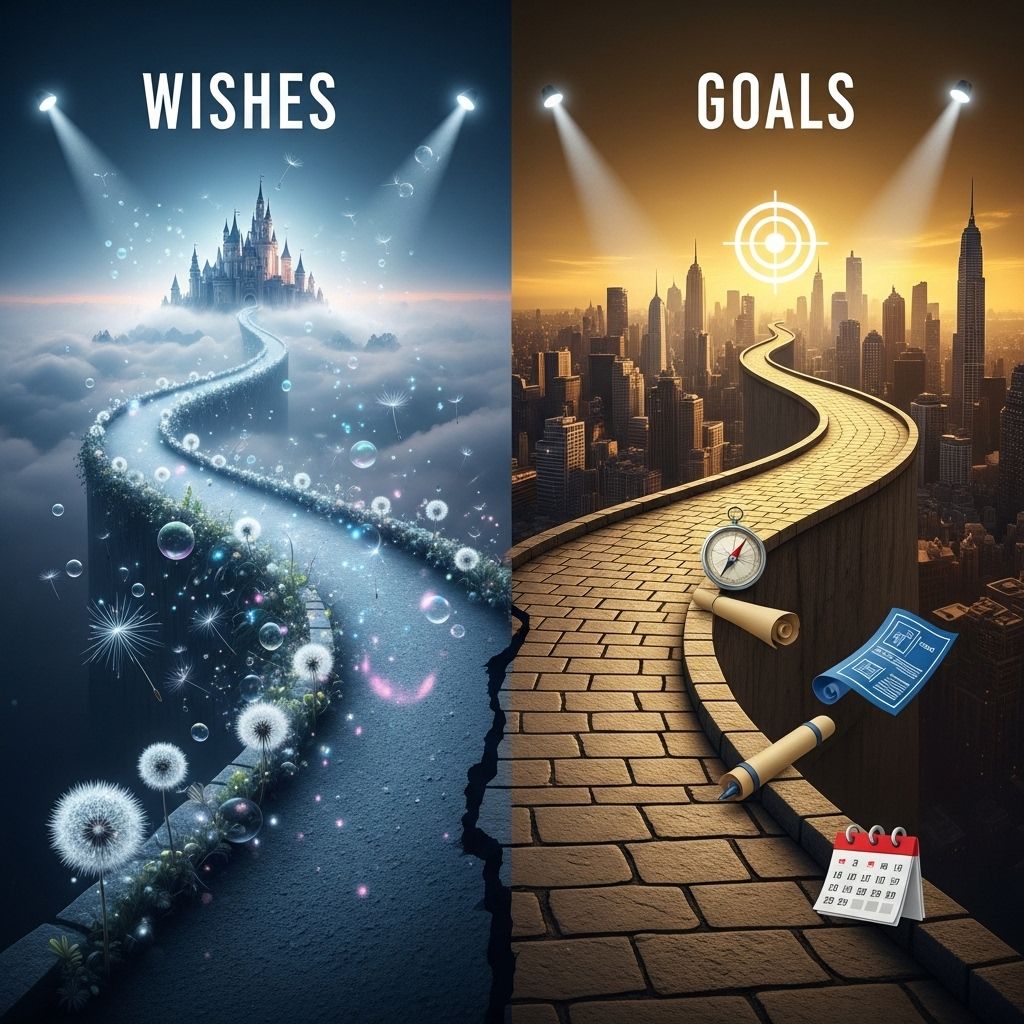Wishes vs Goals: The Critical Difference Few Understand
Learn to distinguish between wishes and goals—and unlock the mindset and strategy needed for genuine achievement.

Wishes vs Goals: One Neat Trick Your Doctor Does Want You To Know
There is a major, often overlooked difference between wishes and goals. Understanding and acting on this distinction is crucial for actual transformation in your health, fitness, career, or any part of life. Yet this clarity is so rare that many spend years pursuing hopes with no meaningful outcome—trapped in the comfort of ‘wishing’ instead of committing to real ‘goals’.
Why Many People Get Stuck on Wishes
In today’s world, we are surrounded by products, trends, and fads that promise transformational results. Ever wonder why organic wine, detox teas, or magic supplements are so popular? Simply put: most people don’t understand the difference between a wish and a goal. We buy, try, and hope, mistaking the vague feeling of doing ‘something’ for real progress. But intent is not impact.
The Wish: Non-Action Masquerading as Action
Wishes are desires. They’re emotional, comforting, and almost always non-specific. More importantly, wishes are not measurable or quantifiable. They’re largely exempt from reality checks because they’re not anchored in objective actions or outcomes.
Wishes often arise from fear or hope, such as “I don’t want to get cancer, so I’ll eat more/less [insert food]” or “I hope I get promoted next year.” These sentiments may feel proactive, but they lack the specifics needed for follow-through.
- Wishes provide a psychological safety net. By wishing, you immunize yourself from failure because there is no defined outcome to miss or achieve.
- Wishes often masquerade as plans, offering just enough comfort to feel like progress.
- In reality, wishes rarely disrupt your behavior, mindset, or routines.
Wishes are usually mistaken for goals because we can fool ourselves into believing we’re taking steps toward them. But unless what you want is measurable, actionable, and tethered to reality, you’re not bringing yourself any closer to genuine change.
Common Examples of Wishes
- “I hope I lose weight this year.”
- “I wish I had more energy.”
- “I hope I’m never diagnosed with heart disease.”
- “I don’t want to get cancer, so I’ll eat more blueberries.”
- “I hope next month is easier than this one.”
Notice how none of these statements specify how, when, or with what metric success will be judged. If there’s no clear finish line, measuring progress or success becomes impossible.
Goals: Defining, Measuring, and Achieving Change
Unlike wishes, goals require clarity. They are specific, measurable, and actionable outcomes that you commit to achieving within a defined period. Goals are built on reality and accountability.
| Aspect | Wish | Goal |
|---|---|---|
| Definition | Desire or hope unanchored from action or reality | Clear, specific outcome with actionable steps |
| Measurability | Not measurable | Always measurable |
| Accountability | None; failure is impossible to identify | Clear benchmarks for success and failure |
| Emotional Comfort | High (protects ego from risk/failure) | Low-to-moderate (risk of failure is real—and so is the satisfaction of achievement) |
| Action | Rarely prompts change | Demands consistent, concrete action |
Goals bring order to your ambitions. They transform abstract hopes into concrete steps, offering you something to strive for and, more importantly, a way to assess your real progress. If a wish is a vague destination, a goal is a GPS waypoint with directions, timing, and a clear sense of arrival.
Turning a Wish into a Goal
To convert a wish into a goal, follow this three-step process:
- Get Specific: Define exactly what you want to achieve. Instead of “I wish I was healthier,” say “I will walk 30 minutes every day for the next 8 weeks.”
- Make It Measurable: Decide how you’ll track success. What does completion look like? For weight loss, it could be “lose 10 pounds” rather than “get in shape.” For diet, it could be “eat five servings of vegetables daily.”
- Set a Timeline: Deadlines are not optional. Goals without time constraints revert to wishes. For example, “run a 5K in 10 weeks” is a goal; “I’ll try to run more” is a wish.
Only with these elements in place will you be able to take meaningful action and hold yourself accountable.
Why Goals Work—and Wishes Don’t
- Goals create pressure to act. This positive stress prompts you to plan and follow through.
- They force you to confront your current reality and the gap to your desired state.
- Goals drive resourcefulness, adaptation, and learning—since you’ll need to adjust your strategies as you progress.
- Achievement, or even progress towards a goal, leads to a genuine sense of growth and satisfaction. In contrast, wishes offer only fleeting comfort.
When you’re honest about your desires, you can turn them into targets—and get to work. Until then, wishes keep you safely disconnected from real change.
How to Distinguish and Transform Wishes to Goals
Wishing and hoping is passive; goal setting is active. Here are practical ways to distinguish between the two and harness wishes as fuel for goal-setting:
- Ask: Can I measure this? If not, refine your wish until it’s quantifiable.
- Ask: What action am I taking? If your answer is, “Nothing yet,” you’re still in wish territory.
- Use the ‘Litmus Test’: If you fail, is it clear that you failed? If yes, it’s a goal. If no, it’s just a wish.
- Identify underlying motivation: Use your wishes to uncover what truly matters to you, then set a goal around it.
Every wish reveals a latent desire. Instead of letting that desire languish in hope, use it to create a practical, specific, and meaningful goal.
Common Mistakes in Goal Setting (and How to Avoid Them)
Even when attempting to set goals, people often fall into subtle traps that undermine progress. Watch out for:
- Vague Goals: Goals like “be happier” or “get fit” are too broad. Specify your outcome.
- Goals Based on Others’ Expectations: If your goal is someone else’s desire, motivation will dwindle. Make it personal.
- Absence of Deadlines: A time frame is essential. Otherwise, you’ll find yourself ‘always trying’ with nothing to show.
- Ignoring Reality: Goals must be aspirational yet achievable. Setting unrealistic targets leads to frustration and abandonment.
Wish-to-Goal Conversion Table
| Wish | Converted Goal |
|---|---|
| I wish I could lose weight | I will lose 12 pounds in 3 months by exercising four days per week and tracking calories daily. |
| I hope I get stronger | I will increase my bench press by 20 lbs in the next 10 weeks, lifting three days per week. |
| I wish I had more energy | I will go to bed by 10:30 PM every night and track my sleep for the next 30 days. |
| I hope my next exam goes better | I will study for two hours daily and complete three practice exams before the next test in four weeks. |
Action Steps: Making Real Progress
Ready to move from wishing to winning? Here are actionable steps to cement the transformation:
- Write your goal down. Make it visible (on your desktop, fridge, or calendar).
- Tell someone. Accountability magnifies commitment.
- Monitor progress. Set intermediate benchmarks along the way.
- Review and adapt. Goals are guides, not prisons. If you hit a snag, modify your approach, but never the standard of specificity.
- Celebrate milestones. Recognize achievement to reinforce positive behavior.
Frequently Asked Questions (FAQs)
Q: Why do so many people confuse wishes for goals?
A: Because both are shaped by desire, but only goals demand the vulnerability of potential failure and concrete action. Wishes are safer emotionally, requiring no risk or change.
Q: How can I quickly spot whether something is a wish or a goal?
A: Ask yourself: Is my outcome clearly defined and measurable? Is there a plan of action and a deadline? If not, it’s a wish.
Q: Can wishes ever be useful?
A: Absolutely. Wishes point to your underlying motivations and desires. The key is to use them as a springboard for constructing specific, actionable goals that you can pursue.
Q: What if I fail to achieve my goal?
A: Failure is part of any meaningful process. Analyze what went wrong, adjust your strategy, and try again. The goal of setting goals is progress, not perfection.
Q: Is it better to set small, easy goals or big, ambitious goals?
A: Both have value. Small goals build habits and momentum; ambitious goals stretch your potential. Use a mix: set large goals and break them into smaller, achievable steps.
Key Takeaways
- Wishes are non-specific, safe from measurement, and don’t require action.
- Goals are defined, measurable, actionable, and anchored in reality.
- The difference is not just semantic—it’s the dividing line between hope and progress.
- To achieve real outcomes, use wishes as your starting point, then ruthlessly clarify, quantify, and plan your path. Only then does transformation begin.
Next time you catch yourself “wishing,” turn it into a tangible goal. The rest is up to you—and your actions.
Read full bio of Sneha Tete












